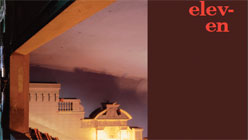Has that increased over the years?
It’s pretty much been that way since I took over, and part of it is just simply a sense of wanting to be the best magazine that we can be, and also a sense of how to shape a magazine. The slush pile is like a junk shop: it’s like you wander in there, and there’s gonna be some really amazing things you’re gonna find, but if you build your entire magazine out of stuff you find in the junk shop, it’s going to be a very random-looking magazine, and it’s not necessarily going to have people that you’ve heard of that are going to draw you to the magazine. So, that’s one of the reasons why solicitation is important.
Another reason we do solicitation a lot is it’s important for the students to meet other writers, especially more established writers. And so having them go out there and approach people that they might be intimidated by and ask them for work allows them to form relationships, connections — networking that enables them to do more when they graduate.
So you have students blitzkrieg authors at readings?
We encourage them to go to readings, yes, at the beginning of each semester they bring a list of writers they are interested in to class… My ambition with the class is that I hope my students become publishers… So I kind of wear two hats; one hat is of a teacher, and I’m teaching students about the culture of literary publishing, the culture of journals, the ethics of producing a journal, what’s out there in terms of marketplace and what are the different choices and modalities of publishing.
Do all of the students/staff members share similar capacities?
Everyone reads. Everyone votes. Everyone works. We all wear different hats. There’s content providing in the sense of soliciting writers, and being in charge of a certain area of the magazine [but]… Everyone has to be involved with marketing, everyone has to be involved with production. And that’s important because if you don’t learn all those skills — if you specialize too early — then when you’re starting your own publication… you’re not going to really be able to do a journal. It’s like all you are is tasteful; taste is great, but you need chops.
What would you say are the most important defining characteristics of Eleven Eleven?
One of the ways I see Eleven Eleven is it’s not so much an artifact or an object as it is a network. A place where lots of different writers and people get to crisscross and communicate. And it continues beyond publishing the writers’ work.
So, for example, one of the things we’re very active about is promoting the work of the people we publish. So, we have a Facebook fan page that has almost 5,300 people, and we use that as a platform for marketing people’s books. So if a writer has work that’s been featured in Eleven Eleven, whenever they have a book out we’ll post links toward purchasing their books. We do the same for visual artists in terms of when they have gallery shows. We do the same for presses that we collaborate with. And when writers are doing tours we’ll promote their readings when they’re in the Bay Area and help them and assist them with setting them up. So if you get published by Eleven Eleven you’re part of our family, and we want to stick around with you not just past when you have your first piece published with us. A lot of journals… it’s really nice when you’ve been published, but then they pretty much just forget about you. And it’s like, I want Eleven Eleven to be deeper than that, to have a deeper connection than that.
I like to think we have a quirky sensibility. We look for work that’s playful; we look for work that’s powerful, that’s emotional; we look for work that’s heterogeneous, in the sense that we don’t want to just publish one school of writing… One thing that I stress to my students is you can do more than just admire someone’s writing; you can publish it. So it enables you to have a deeper connection to the things that you love.
What’s your favorite part of the job?
I feel like the most fun thing about doing Eleven Eleven as part of the class are those teaching moments of being able to have those really good discussions about writing and where writing’s going and where you want writing to go, and the way in which a journal is a kind of advocacy for the sort of writing that you’re passionate about, and by connecting writers that wouldn’t normally be connected you’re creating your own micro-canon; you’re saying ‘this is the way I think writing should be.’
It’s strange to think about a class putting together their own textbook, in a way.
In a way, but that’s exactly what it is.


